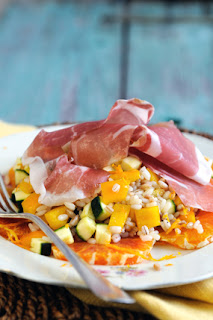“Langhirano, Langhirano, Langhirano, let’s go to Langhirano” said Gigi as we pondered over a glass of wine on a Saturday evening, how we might usefully pass our time the following morning. It was a great idea. It certainly beat his other suggestions – too cold to go to the market, far too much snow to go walking the dog in the mountains. Not everyone has heard of Langhirano. But immediately he said the name, I knew what he had in mind. Langhirano, otherwise known as the capitale del prosciutto, is the very epicentre of Italy
A good Parma Parma Parma Parma
With the shopping taken care of, Gigi and I made our way into the centre of town. We figured we deserved a treat, after all our effort. The truth is, this is what we’d really come for. Langhirano’s a small town and everyone knows about the little trattoria in the main piazza. Needless to say, it specialises in the local ham and if you want to sample Parma ham at its very, very best, there’s arguably no better place in Italy
Mixed grains, vegetable & Parma
Insalata di cereali misti, verdure crude e prosciutto di Parma
Like I said, there’s no better vehicle for Parma Parma
Serves 4
Preparation time: 10 minutes
Cooking time: 15 minutes
Ingredients
250g mixed grains including rice, spelt and pearl barley
2 medium sized sweet yellow peppers
4 small young courgettes
2 untreated oranges
12 slices of Parma
4 tablespoons of extra virgin olive oil
Salt/pepper
Method
Boil the mixed grains in salted water until cooked. You can purchase bags that contain all three grains and have an equal cooking time which makes things much easier. If you can’t find this, just use one of your favourite grains. Once cooked drain, transfer to a large mixing bowl and set aside to cool completely. To make the salad, chop the peppers and courgette into small dice and add to the bowl. Make a dressing by mixing together the juice and zest of one orange with the olive oil. Add this to the bowl and stir everything together. Check for seasoning and add salt & pepper to taste. To serve, I like to peel and finely slice the oranges and arrange them on a serving plate. Place the salad on top and, finally, finish with several slices of Parma



Sounds like I should try and get to Langhirano then Mario.
ReplyDeleteIt's heaven for ham lovers Cathy!
ReplyDelete